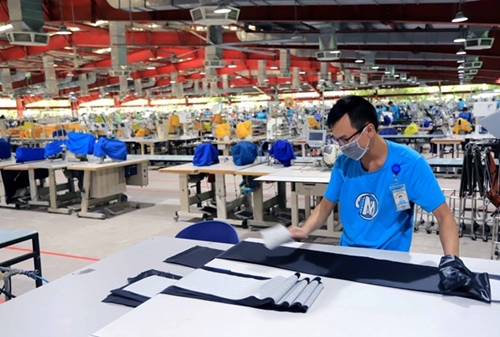    |
 |
|
A garment factory of the Maxport Limited Vietnam in Thai Binh province |
S&P Global said that after improving in August, overall business conditions in the Vietnamese manufacturing sector declined marginally in September.
Underlying data pointed to a strengthening demand environment and growing business confidence, but also a degree of spare capacity in the sector which led to reductions in output and employment. Rates of inflation gathered pace, with both input costs and output prices rising more quickly at the end of the third quarter.
The PMI stood at 49.7 points in September, back below the 50.0 no-change mark following a reading of 50.5 in August. The index thereby signaled a deterioration in business conditions for Vietnamese manufacturers, albeit one that was only marginal.
The most positive aspect of the latest survey was a second successive monthly increase in new orders, with the rate of expansion broadly in line with that seen in the previous survey period. A number of respondents signaled that strength in new export orders, particularly from other Asian economies, had helped to boost total new business. The rate of expansion in new sales from abroad was solid and more pronounced than that seen in August.
Despite the continued pick-up in demand, manufacturers signaled that new order receipts remained relatively modest, leading to a scaling back of production. Output was down slightly following August's rise, with production now having fallen in six of the past seven months. The overall contraction in output was centered on intermediate goods producers, while the consumer and investment goods categories recording expansions, according to S&P Global.
It said that a further reduction in backlogs of work in September signaled that manufacturers maintained sufficient capacity to cope with current workloads. As such, there remained a reluctance to hire additional staff. Employment decreased for the seventh month running. Although modest, the rate of job cuts was the most marked since June.
While manufacturers lowered their staffing levels, they did expand their input buying. Purchasing was up for the second month running in response to growth of new orders and plans to increase output in the coming months.
These expansion plans were also evident in data on business confidence, which strengthened for the fourth consecutive month and was the highest since February. Firms expect new orders to improve further, thereby leading to output growth. Around 45% of respondents predicted output to rise over the coming year, against 7% that were pessimistic.
Although demand for inputs strengthened again in September, suppliers continued to speed up their deliveries. Lead times shortened for the ninth consecutive month, albeit to the least extent since April.
Stocks of both purchases and finished goods decreased at the end of the third quarter, in both cases for the first time in three months. Stocks of finished goods were used to help meet new export orders.
“The picture was mixed in the Vietnamese manufacturing sector during September. On a positive note, firms continued to see demand pick up, with a particularly encouraging rise in new orders signaled. This fed through to greater confidence in the year-ahead outlook,” said Andrew Harker, Economics Director at S&P Global Market Intelligence.
"On the other hand, there is clearly still some excess capacity in the sector, which meant that firms continued to lower employment and also scaled back output slightly, opting to use the inventories that had been building up in recent months to help meet new orders,” he noted.
Harker added that should demand continue to pick up, this should feed through to growth across the sector. If the recovery in new orders loses steam, however, firms will remain reluctant to expand capacity too quickly.
Source: VNA